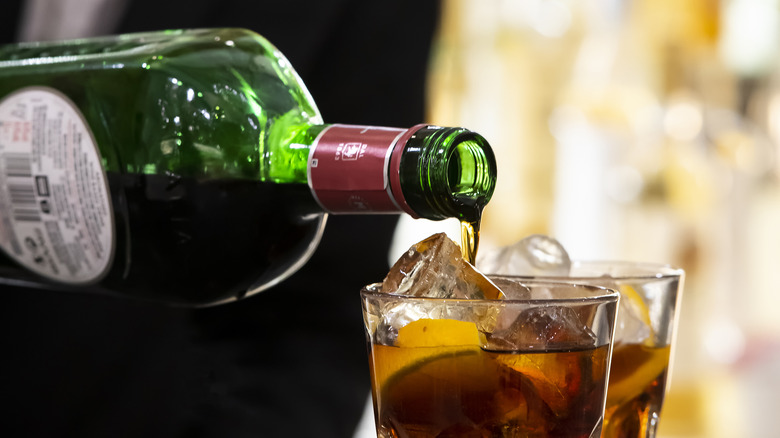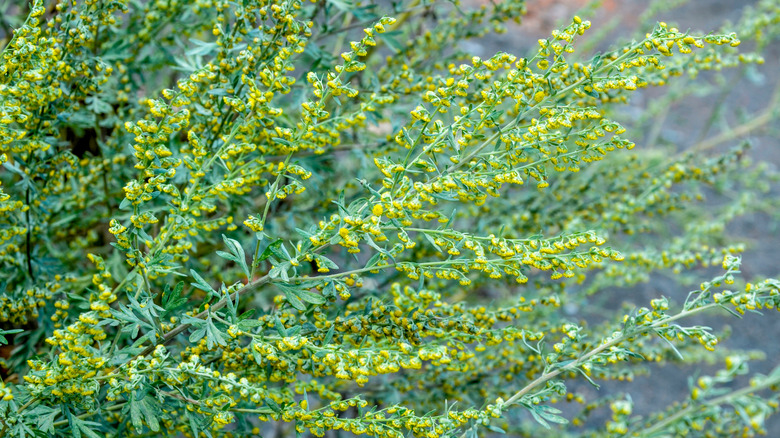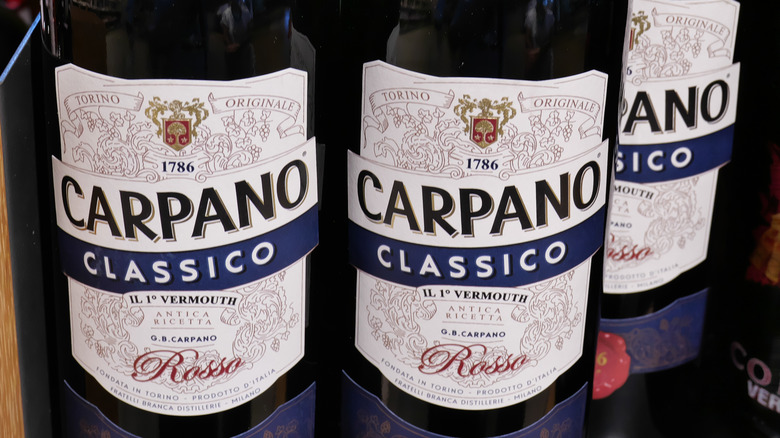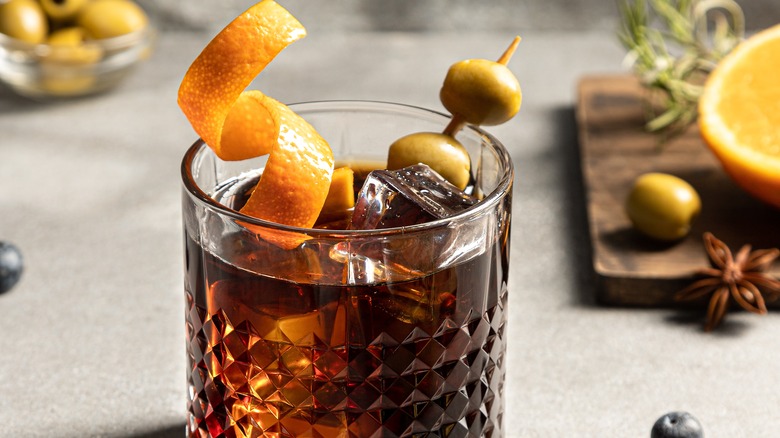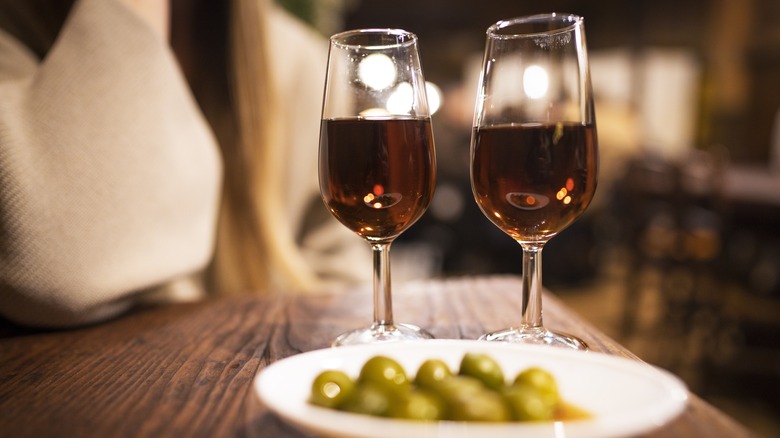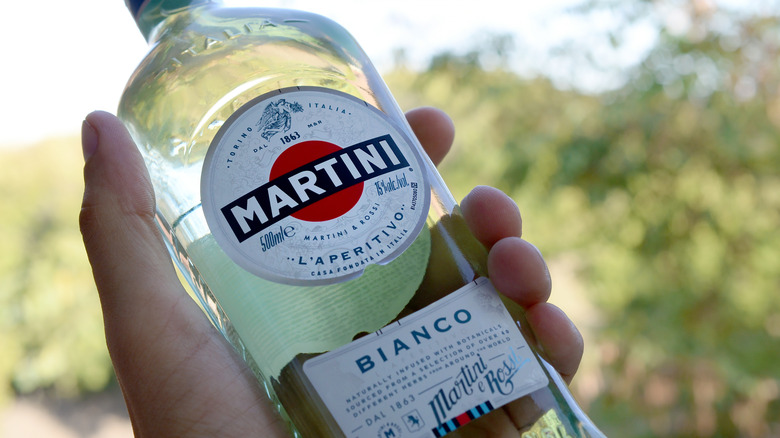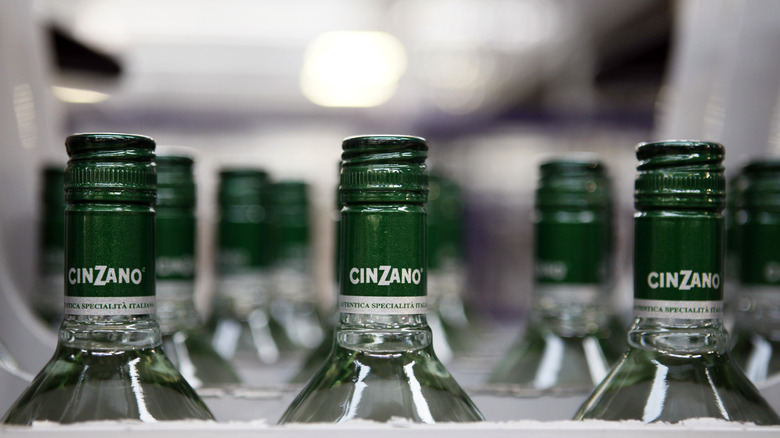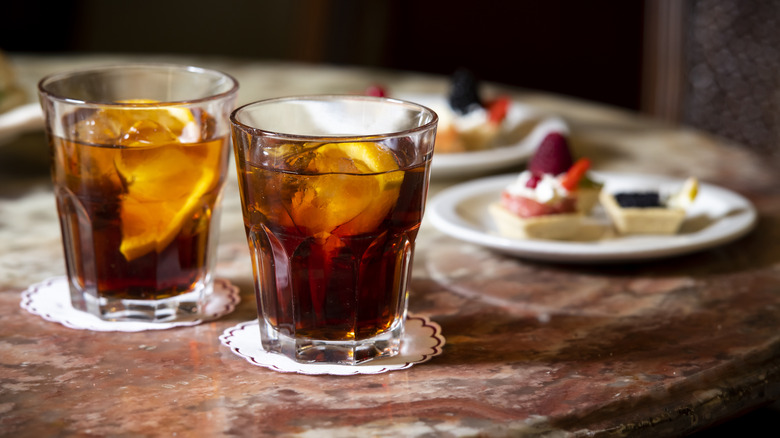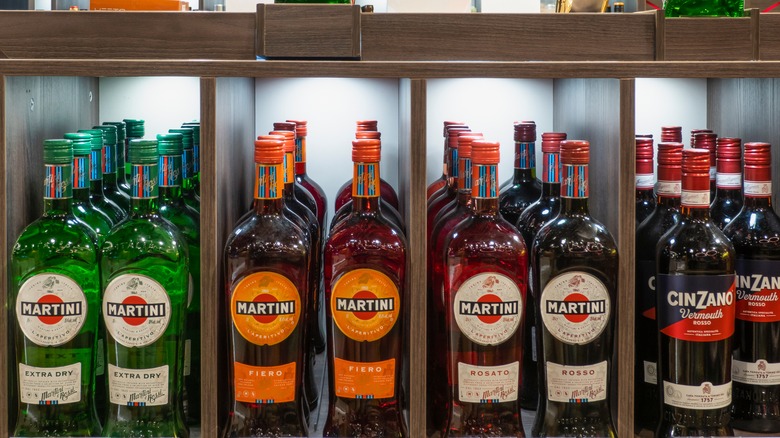The Ultimate Vermouth Guide: Everything To Know About The Fortified Wine
Like many of our favorite spirits and liquors, vermouth originated as a medicinal drink. Its origins date back to ancient civilizations, such as Greek and Chinese, and are tied to their medical knowledge. It is believed that the ancient Chinese mixed wine with honey, rice malt, and other health-boosting botanicals, creating the very first version of vermouth. This recipe likely made its way to Europe through the Silk Road, the commercial route that connected China with the West.
Eventually, France and Italy became vermouth production hotspots, particularly the Piedmont and Savoie regions, so we have the Italian and French to thank for the medicinal liquid's transformation into a delicious and beloved fortified wine. It was in Turin, Italy, where vermouth became a popular aperitivo around the 18th century, thanks to Antonio Benedetto Carpano, who had knowledge in the arts of herbalism. Carpano, whose name you may recognize from certain bottles of vermouth, was the one who began to commercialize this fortified wine and called it wermut, which means wormwood in German.
The liquid that we now call "vr-mooth" arrived in America in 1853 for the New York City World Fair. Although it wasn't very well-received at first, it took off in the 1860s, when bartenders realized vermouth its power as a mixing ingredient, and began to incorporate it in cocktails.
How is vermouth made?
Vermouth is a fortified wine, so production begins with red or white wine — although it is almost always white. The wine gets an additional punch from a strong spirit, such as brandy or grain spirit (a neutral spirit usually made with ingredients like rice or barley). The added alcohol helps to stop the fermentation process. The liquid is also infused with several herbs, spices, fruits, and botanicals that give vermouth its distinct flavors and aromas. These herbs and spices will vary depending on the production region, but some of the most popular ingredients are orange peel, Angelica root, star anise, juniper, and wormwood.
In Italy, for example, the law dictates that vermouth must contain at least 75% wine and include alcohol infused with herbs and spices, including artemisia (wormwood). In fact, Vermouth di Torino, the same one perfected by Antonio Benedetto Carpano back in the day, has had an appellation of origin since 2017. This law protects regional vermouth production and states that vermouth must be made with white wine from Piedmont to earn the name Vermouth di Torino and be marketed as such.
Styles of vermouth
When we think of types of vermouth, we usually think "sweet or dry," but this fortified wine has more range than we may think. Sweet vermouth, also known as vermouth rosso, is traditionally made in Italy. Earthy, spicy, and aromatic, it boasts notes of cinnamon, nutmeg, and clove, and is perfect in a classic cocktail such as a Manhattan or Negroni. Sweet vermouth, however, can be white or red, both of which can be used in a cocktail with equally good results.
Dry vermouth, usually made with wormwood, hails mainly from France. It has lighter hues, and its notes are herbal, floral, and slightly savory. That's why it's perfect in a martini, as it balances out the botanical flavor of gin. As for extra-dry vermouth, it's less sweet and more citrusy and is also great in a martini or a cocktail with an acidic profile.
Vermouth bianco or vermouth blanc stands between these categories, sweet but not too sugary. Although flavor profiles will vary depending on the brand, it can go from spicy to bitter and is a delicious aperitivo when served on the rocks. As for amber vermouth, it also lives somewhere between red and dry vermouth and usually boasts floral and fruity notes. This makes it work well in a cocktail or as a spritz with sparkling water. Last but not least, if you're looking for a vermouth with a touch of creativity, there are flavored versions infused with ingredients such as cocoa or grapefruit.
How to serve vermouth
Vermouth is essential in any bar, and not just because it's a mandatory ingredient in classic cocktails like Negronis. There are several ways to enjoy vermouth, and they depend on the style you're drinking. To fully appreciate the aromas and flavors in your vermouth, try it neat or on the rocks, especially if you're trying a premium liquid.
You can take your sipping experience to the next level by experimenting with garnishes, which help bring out different aspects of your drink and are oh-so European. If you're sipping on an Italian vermouth, add a slice of lemon or a sprig of fresh herbs, matching its profile. Olives are great in dry vermouth, as are capers or onions, bringing out the drink's saline notes. And on a warm summer day, a vermouth spritz makes for a lovely, low-proof drink. A dry vermouth will work well with tonic water, while a sweet vermouth will benefit from fresh sparkling water.
Tasting and drinking vermouth
To us mere mortals, finding aromas and tasting notes can sometimes feel challenging. Sipping vermouth is an excellent way to awaken your senses and discover different notes, as these can vary quite a bit depending on the region, style, and brand you're choosing. Take your time, and appreciate the hues and aromas in your vermouth before you take your first sip.
Generally speaking, sweet vermouth has a fuller body and a higher sugar content. Take a sniff and you'll usually detect notes of cinnamon and vanilla, as well as vanilla, cocoa, caramel, and dark fruits on the palate. Herbs like wormwood and gentian root provide a bitter touch. Dry vermouth is usually lighter, less sweet, and more bitter. Dry vermouth usually offers notes of rosemary and lavender on the nose, and floral, herbal, and fruity notes on the palate thanks to the presence of botanicals such as juniper and chamomile. As for vermouth bianco, it boasts sweet, herbal, and fruity notes and its taste is a little more potent than that of dry vermouth. As a general rule, Italian vermouth bianco is sweeter than its French counterpart, vermouth blanc.
Vermouth in cocktails
Vermouth's versatility has made it a favorite among bartenders for decades. Depending on the type of vermouth, it can bring sweetness or bitterness, and more depth to your drink of choice. The classic Martini, for example, pairs dry vermouth with gin or vodka. Vermouth brings fresh notes and a touch of bitterness that goes beautifully with the herbal aspects of gin or vodka. Garnished with olives or a lemon twist, it's as potent as it is elegant and balanced.
Another great example is the Americano — the Negroni's predecessor —, made with equal parts of Campari, sweet vermouth, and sparkling water. To turn it into a Negroni, substitute the sparkling water with gin. From there, you can experiment with variations such as a Negroni Sbagliato — with Prosecco instead of gin – or a Boulevardier – with bourbon taking the place of gin.
And we can't talk about vermouth cocktails without mentioning the Manhattan, prepared with sweet vermouth, bourbon, and bitters, and garnished with a twist of lemon and a maraschino cherry. Whatever your taste is, these cocktails showcase vermouth's sweetness and aromatic notes.
Alcohol content and nutritional info
As a fortified wine, vermouth has a lower alcohol content than liquors and spirits, and it usually ranges between 15% and 18%. For reference, consider that a 12-ounce beer stands at an average of 5% alcohol, a glass of wine is 12% alcohol, and a spirit like vodka or tequila is 40% alcohol.
Although vermouth's profile and properties vary depending on the style and production method, it generally contains 45 calories per ounce. A standard serving of vermouth will also contain 2.7 milligrams of sodium and 209 milligrams of calcium. Vermouth has no fat, fiber, or protein. As for sugar content, it depends on the type of vermouth you are drinking. Sweet vermouth contains about 150 grams of sugar per liter, while dry vermouth stands at around 50 grams of sugar per liter. Extra-dry is the least sugary of the bunch, containing less than 30 grams of sugar per liter.
Storing vermouth
As a general rule, vermouth has a longer shelf life than wine. Sugar is to thank for here, as it slows the aging process in vermouth. This doesn't mean it will last forever, though. Vermouth has a lower survival rate than regular spirits like whiskey or rum because it begins to oxidize and lose its quality over time.
A brand-new bottle of vermouth can last between three and four years when kept in a cool, dry place. Once you've popped a bottle open, you can store it at room temperature for up to a month, or in the fridge for up to three months. A sure sign of vermouth being past its prime is a significant color change. For dry and white vermouths, this means that the golden color turns to amber; for sweet vermouth, a dull color is bad news. Since sugar content plays a part in the aging process, sweet vermouth will last a little longer than its dry counterpart thanks to its higher sugar content.
Perfect food pairings
Traditionally, vermouth is served as an aperitivo, which means it goes beautifully with classic bar snacks such as olives, salty cheeses, or pretzels. Picture yourself in a neighborhood bar in Madrid, sipping on vermouth while feasting on pieces of Manchego cheese and tortilla de patatas, and you'll get the picture.
However, its wide range of aromas and flavors opens the door to many interesting pairing options. Cocktails that contain sweet vermouth are great companions to Asian stir-fry dishes and fresh salads, especially those prepared with chicken or contain fruit. Dry vermouth, on the other hand, makes for the quintessential appetizer/aperitivo combo when served with a traditional charcuterie board featuring cold cuts, cheeses, olives, and nuts. It also goes beautifully with seafood, especially shellfish — oysters and a Martini, anyone? White vermouth is excellent as an ingredient in sauces – think pasta or chicken –, or as a digestif. Sweet elements such as coconut, chocolate, or honey blend very well with this vermouth's botanical profile.
Popular vermouth brands
Whether you are planning to stock your home bar with a few bottles or thinking about what to order on your next bar outing, vermouth offers plenty of excellent options to explore. Negroni lovers can't go wrong with Cinzano Rosso, the ultimate sweet vermouth. And if you're craving a Martini, try California-based Lo-Fi Aperitifs Dry Vermouth, with notes of spice, citrus, and elderflower.
For a sweet, aromatic vermouth to enjoy on the rocks, Cocchi Americano Rosa has our seal of approval, as does cult favorite Perrucchi, a Spanish vermouth with notes of ginger, lemon, and orange blossom. If you're looking for a premium experience, try Dolin Vermouth de Chambéry Dry. Infused with 15 herbs and spices, it's as delicious on its own as it is in cocktails. And if you want to make a refreshing summer spritz, look no further than Ransom Dry Vermouth, made with a blend of white wines. This American vermouth is herbal and bittersweet, making it perfect for vermouth and tonic.
Vermouth bars around the world
Europe has had a long love story with vermouth, an ever-present tradition of pre-meal drinks and hot summer days. Vermouth bars in Europe can give you a sense of this tradition. Madrid's Casa Alberto in the artsy Barrio de las Letras, or the no-frills Bodegas Ricla, near Plaza Mayor, is perfect for an afternoon of vermouth and tapas. Over in Turin, the birthplace of the Italian vermouth, a visit to the Martini Café Torino is a pilgrimage that is not to be missed.
The vermouth trend has reached our side of the Atlantic over the past few years. Miami's Coconut Grove is now home to Victoria's Vinos y Vermuteria, a hip space focused on house-made vermouth, Spanish ciders, and wines. In New York, José Andrés' Mercado Little Spain is an excellent option to have the vermutería experience. Head to the aptly named Bar Celona for vermouth, cocktails, and excellent bites. And if you're in Mexico City, the recently opened Oropel in Colonia Roma pours a wide array of vermouths and remarkable Negronis in a cozy yet cool space.
